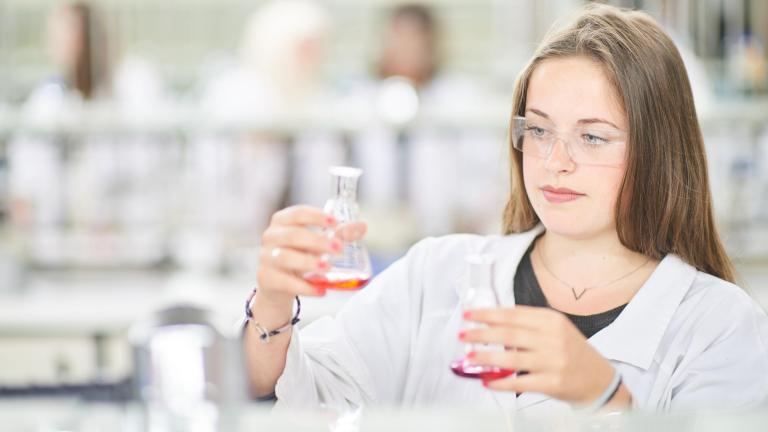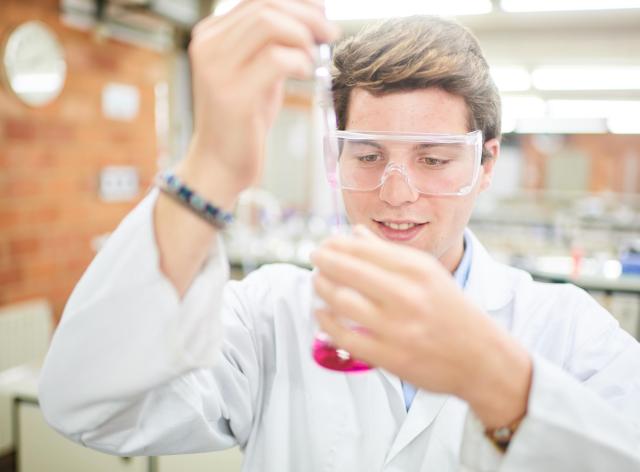Chemistry is par excellence the science of transforming matter, and as such lies at the crossroads between the physical sciences and mathematics on the one hand, and the life sciences, earth sciences and materials sciences on the other. State-of-the-art laboratories, led by world-renowned researchers, are dedicated to a wide range of fields, from organic chemistry to materials chemistry, analytical chemistry and theoretical chemistry.
Find out more about the Chemistry Department
Spotlight
News

10 years of UNamur - STÛV collaboration: a lever for innovation, attractiveness and excellence
10 years of UNamur - STÛV collaboration: a lever for innovation, attractiveness and excellence
The University of Namur and STÛV, a Namur-based company specializing in wood and pellet heating solutions, are celebrating ten years of fruitful collaboration. This partnership illustrates the importance of synergies between academia and industry to improve competitiveness and meet environmental challenges.

For over 30 years, UNamur, via its Chemistry of Inorganic Materials Laboratory (CMI) headed by Professor Bao-Lian Su, has excelled in fundamental research into catalytic solutions capable of "cleaning" air and water. In 2014, STÛV approached this expertise to design a sustainable, low-cost smoke purification system for wood-burning stoves, in anticipation of the tightening of European standards.
The R-PUR project: a decisive first step
From this meeting was born the R-PUR applied research project, funded by the Walloon Region and the European Union as part of the Beware program, led by Tarek Barakat (UNamur - CMI). Between 2014 and 2017, an innovative catalytic filter was thus developed within the laboratory, in close collaboration with STÛV.
From 2018 to 2024, the technologies patented by STÛV and UNamur and the pollutant measurement equipment were gradually transferred to STÛV, at the same time as Win4Spin-off and Proof of Concept funding enabled technological and commercial maturities to be increased to meet market needs. These steps led to laying the foundations for a new Business Unit at STÛV, with the hiring of Tarek Barakat as Project Manager, and raising investments to produce the catalytic filters.
What about tomorrow? Towards zero-emission combustion
The UNamur-STÛV collaboration continues today with the Win4Doc (doctorate in business) DeCOVskite project, led by PhD student Louis Garin (UNamur - CMI) and supervised by Tarek Barakat. Objectives:
- Develop a second generation of catalysts to completely reduce fine particle emissions.
- Limit the use of precious metals.
- Sustain biomass combustion and make STÛV the world leader in zero-emission stoves.
A winning partnership for the region
This collaboration has enabled:
- The acquisition and transfer of know-how and equipment between UNamur and STÛV to validate results under industrial conditions.
- The organization of multidisciplinary workshops, such as the one on October 14, promoting the sharing of expertise around biomass combustion and sustainable development.
Success-Story: interviews and testimonials
At the end of October, members of UNamur and STÛV came together to take part in a workshop organized by UNamur's Research Administration and STÛV. The aim? To highlight the benefits of collaborative research between companies and universities on subjects ranging from energy, the environment, profitability, ethics and regulation to sustainable development. The two partners discussed their collaboration, expertise and development prospects.
Discover the details of this success story in this video :

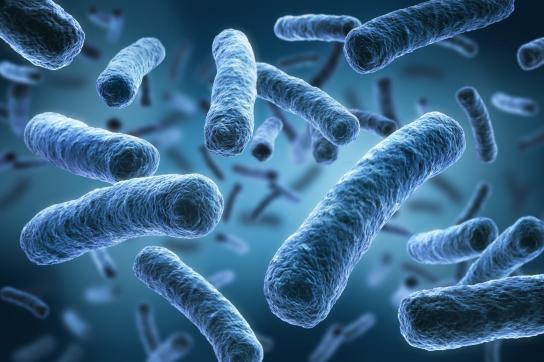
DCF, a molecular weapon against bacterial defenses
DCF, a molecular weapon against bacterial defenses
At a time when bacterial resistance to antibiotics is a public health problem, Professor Stéphane Vincent's team is currently developing dynamic constitutional frameworks (Dynamic Constitutional Frameworks, DCF): a molecular system that would be able to break down certain resistances and thus deliver antibiotics as close as possible to pathogens.
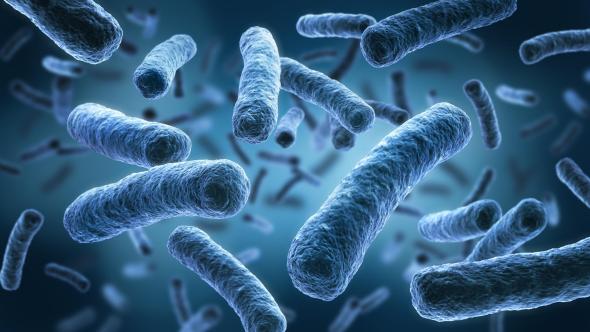
Scientific discoveries are like great stories: they often begin with an encounter. Nearly 20 years ago, Professor Stéphane Vincent of UNamur's Laboratoire de Chimie Bio-Organique, then a young sugar chemist, was in search of something new. During a post-doctorate in Strasbourg, France, in the laboratory of Jean-Marie Lehn, winner of the 1987 Nobel Prize in Chemistry and a specialist in supramolecular chemistry, he befriended another post-doctoral fellow: the Romanian Mihail Barboiu, now a CNRS researcher in Montpellier.
."Research carried out between Montpellier and Strasbourg has given rise to what we call Dynamic Constitutional Frameworks", reveals Stéphane Vincent. "These are molecules that are constantly assembling and disassembling, which gives them interesting properties. Weakly toxic to animal and human cells, DCFs can interact with essential cell components, such as proteins or DNA."
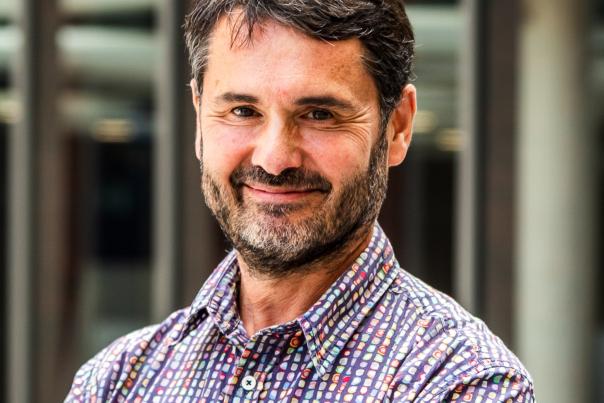
Soon before the Covid-19 pandemic, at a scientific congress, Mihail Barboiu showed Stéphane Vincent the results of his experiments. "He was using DCFs as a kind of transporter, to bring genes (DNA or RNA fragments) into a cell", recalls the chemist. "I then realized that DCFs were positively-charged molecules and readily adapted to DNA, which is negatively-charged. This gave me the idea of using them against bacteria, in the same way as certain antibiotics, which are also positively charged."
An antibacterial turnaround
The two researchers then established an initial research project, with a thesis funded in cotutelle by UNamur, which culminated in 2021 in the publication of the first results showing the antibacterial activity of DCFs. "At the time, I was already working on antibacterial approaches, particularly against Pseudomonas aeruginosa, a major pathogen that forms biofilms", explains Stéphane Vincent.
To combat antiseptics and antibiotics, bacteria proceed in several ways. In addition to developing mechanisms to block the functioning of antibiotics, they are able to aggregate or dock themselves to a surface, for example that of a medical implant, and cover themselves with a complex tangle of all sorts of molecules. The latter, known as biofilm, protects the bacteria from external aggression. These biofilms are a major public health problem, as they enable bacteria to survive even the most powerful antibiotics and are notably the cause of nosocomial diseases, infections contracted during a stay in a healthcare establishment.
"We have shown that certain DCFs are both capable of inhibiting biofilm production, but also of weakening them, thereby exposing bacteria to their environment", summarizes Stéphane Vincent.
The TADAM project, a European alliance!
Bolstered by these results and thanks to C2W, a "very competitive"European program that funds post-doctorates, Stéphane Vincent invited Dmytro Strilets, a Ukrainian chemist who had just completed his thesis under the supervision of Mihail Barboiu, to work in his laboratory on DCFs. The project, called TADAM and carried out in collaboration with researchers Tom Coenye of UGent and Charles Van der Henst of the VUB, then focused on the antibacterial and antibiofilm potential of DCFs against Acinetobacter baumannii, a bacterium which, along with Pseudomonas aeruginosa, is on the list of pathogens of greatest concern defined by the World Health Organization (WHO).
The TADAM project is based on an ingenious assembly: DCFs are associated with special molecules known as pillarenes. The latter form a sort of cage around a proven antibiotic molecule, levofloxacin, thus improving its bioavailability and stability. The DCFs then have the role of inhibiting and disintegrating the biofilm, to enable the pillarenes to deliver their antibiotic directly to the bacteria thus exposed.
The results obtained by Stéphane Vincent's team are spectacular: the DCF-pillararene-antibiotic assembly is up to four times more effective than the antibiotic used alone! Noting that little work had yet been done on the antibiotic effect of these new molecules, the researchers decided to protect their invention by filing a joint patent, before going any further.
For everything still remains to be done. Firstly, because despite more than convincing results, how the assembly works is still obscure. "All the study of the mechanism of action has yet to be done, says Stéphane Vincent. "How is the antibiotic arranged in the pillararene cage? Why do DCFs have antibiofilm activity? How do DCFs and pillararenes fit together? All these questions are important, not only to understand our results, but also to eventually develop new generations of molecules."
And on this point, Stéphane Vincent wants to be particularly cautious. "We all dream, of course, of a universal molecule that will work on all pathogens, but we have to be humble, he pauses. "I've been working with biologists for many years, and I know that biological reality is infinitely more complex than our laboratory conditions. But it's because our results are so encouraging that we must persevere down this path."
The chemist already has several leads: "We're going to test the molecules on bacteria"circulating"suspended in a liquid, which behave very differently. And then we're also going to work on clinical isolates of pathogenic bacteria, to get a little closer to the real conditions under which these biofilms form."
Dmytro Strilets has just received a Chargé de Recherche mandate from the FNRS to develop second-generation DCFs and study their mode of action. The TADAM project has received funding from the University of Namur and the European Union's Horizon 2020 research and innovation program under Marie Skłodowska-Curie grant agreement n°101034383.
This article is taken from the "Eureka" section of Omalius magazine #38 (September 2025).

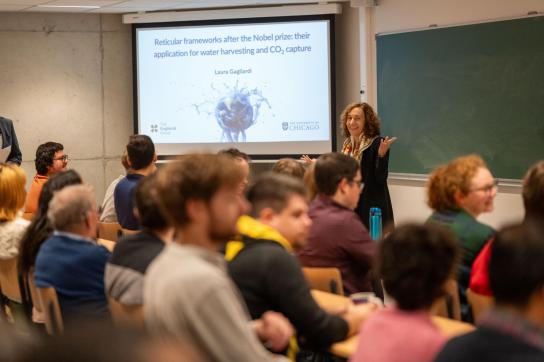
Laura Gagliardi visits the UNamur in the framework of the prestigious Solvay/Syensqo Chair in Chemistry
Laura Gagliardi visits the UNamur in the framework of the prestigious Solvay/Syensqo Chair in Chemistry
Laura Gagliardi is a renowned international researcher at the University of Chicago, recognized for her pioneering contributions to theoretical and computational chemistry, particularly in the study of reticular materials such as metal–organic frameworks (MOFs). The Solvay/Syensqo Chair in Chemistry honors chemists who have made exceptional advances in their fields. As part of this distinction, Professor Gagliardi delivered a series of lectures at several Belgian universities, including a seminar at the University of Namur, Department of Chemistry.
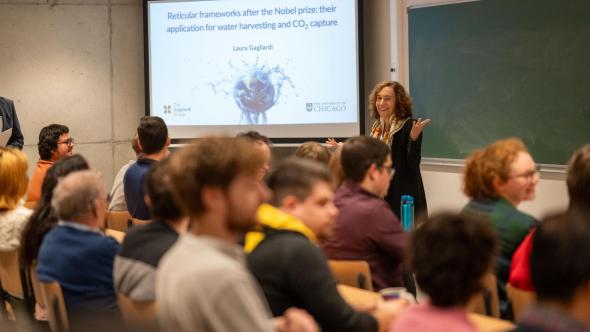
Your research ranges from fundamental to applied chemistry. Can you explain what you do?
My background is in fundamental chemistry and physics—the study of the basic principles that govern matter, from atoms and molecules to the chemical bonds that connect them. During my Ph.D., I focused on developing theoretical concepts and converting them into computer codes, which required a lot of mathematics, rigor, and careful methodology.
I have always been fascinated by physical and theoretical chemistry. Synthetic chemistry in the lab can sometimes be compared to cooking—you follow a recipe and observe the results. My husband is an organic chemist and also the cook in our family; he always tells me to go play the piano while he’s in the kitchen! I’m not allowed anywhere near it. 😊
What truly fascinates me is understanding why things work in a certain way, not just that they work. My group performs computer simulations that allow us to probe reaction mechanisms at the molecular level. These simulations help us explain experimental observations, make quantitative predictions, and even design new molecular systems and materials that can later be tested and refined in the laboratory.
Currently, a large portion of my research focuses on metal–organic frameworks, or MOFs—materials made of metal ions/clusters linked by organic molecules. MOFs are exciting because of their enormous surface areas and highly tunable pore structures, which make them ideal for a wide range of applications. We are particularly interested in using MOFs to address climate change challenges, for example, by capturing carbon dioxide, storing hydrogen, and purifying water. Beyond these, MOFs are also being explored for catalysis, drug delivery, and even as sensors for detecting pollutants and biomolecules.
The Nobel Prize in Chemistry has just been awarded to three renowned scientists: S. Kitagawa, O. M. Yaghi and the late R. Robson for their work on metal-organic structures (MOFs). They have created molecular constructs with large spaces through which gases and other chemicals can flow: to collect water from desert air, capture carbon dioxide, store toxic gases or catalyze chemical reactions.
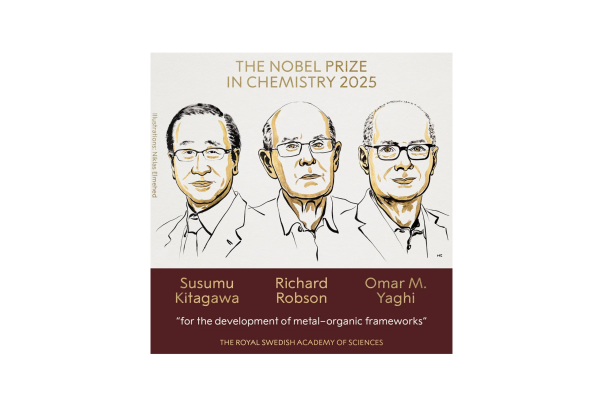
You're a scientific leader in the field of computational chemistry. How did you come to choose this path?
I grew up in Italy, in a very supportive environment. My mother was a mathematics teacher, and my father was an engineer, so I was surrounded by numbers, logic, and curiosity from an early age. I was always drawn to mathematics, physics, and chemistry, and my parents encouraged me to be ambitious and to pursue excellence in whatever I did. Their support and belief in me gave me the confidence to follow my curiosity wherever it led.
During your education, did you encounter difficulties linked to the fact that you are a woman?
Of course. At that time, society was still very stereotyped and biased. My grandfather, who admired my determination, used to say I would become a high school headmaster—that was already considered quite an achievement for a woman then! My professors were kind and encouraging, but when they saw my academic performance, they assumed I would become a high school teacher, which was considered the highest position most people could imagine for a woman in science. Nobody would have said “astronaut” or “CEO of a large company”—those roles were thought to be reserved for men. Things turned out differently. By the time I was doing my Ph.D., my parents were proud of me, though I don’t think they expected me to have this kind of career. And I am truly passionate about my job—it never feels routine.
Do you have a message for the young generation?
The most important thing is to find your passion. You will spend a large part of your life working, so you might as well do something you genuinely love. When you love what you do, you naturally find the strength and motivation to persevere.
I like to quote the Italian author Primo Levi, who wrote in the Wrench: “Finding a job you like is the closest approximation to happiness in this world.” As a woman—and even though things have improved—you still have to work very hard to demonstrate your worth. I deeply believe in excellence, and I value it when I see it in others, regardless of gender. Excellence speaks for itself.
I also believe that family, friends, and mentors are indispensable sources of inspiration. You need role models and supportive figures to help you grow, stay passionate, and strive for excellence. We are fortunate to live in a privileged environment where many opportunities are within reach.
My advice is to use that privilege to make a difference—by finding your passion and pursuing it wholeheartedly.

Laura Gagliardi - Biography
Laura Gagliardi is a professor at the University of Chicago, United States of America.
Picture credit - University of Chicago
After her scholarship in Bologna, Italy, a post-doctoral position in Cambridge, England, she began her independent academic career in Palermo, Italy, then in Geneva, Switzerland. In 2009, she moved to the United States where she was a professor at the University of Minnesota. She remained there until her move to the University of Chicago in 2020. She is the Richard and Kathy Leventhal Professor at the University of Chicago with a joint appointment at the Department of Chemistry and the Pritzker School of Molecular Engineering.
In addition to her dedication to science, Laura is a strong advocate for women in science, technology, engineering, and mathematics.
The Syensqo 2025 Chair in Chemistry at the Solvay International Institutes
Laura Gagliardi was awarded this prestigious Solvay chair in Chemistry for her groundbreaking work on electronic structure methods for complex chemical systems, which highlights her leadership and impact on the world of chemistry.
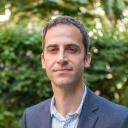
Laura Gagliardi's visit to the University of Namur on October 22, 2025, was an excellent opportunity for undergraduate, master, and doctoral students, as well as postdoctoral researchers from the chemistry and physics departments working in the field of computational chemistry and numerical simulations of functional materials, to meet and exchange ideas with a world-renowned figure.
Chemistry and physics research at UNamur
At the University of Namur, their research is conducted at the Namur Institute for Structured Matter (NISM) and is dedicated to the development and application of new computational methodologies to characterize and understand the properties of functional materials for applications in the fields of nonlinear optics, energy storage, catalysis, organic electronics, photochemistry, and photophysics.
Contacts: benoit.champagne@unamur.be - vincent.liegeois@unamur.be - yoann.olivier@unamur.be
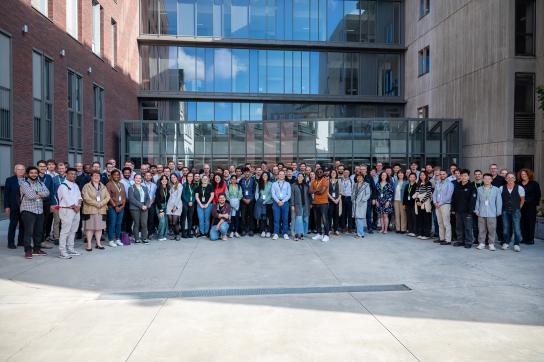
First MG-ERC conference brings together the world's inorganic chemistry elite
First MG-ERC conference brings together the world's inorganic chemistry elite
In early September, the University of Namur hosted the first Main-Group Elements Reactivity Conference (MG-ERC). Over 100 researchers from 12 countries and 32 institutions gathered around Professor Guillaume Berionni. An event hailed as "one of the best chemistry conferences" by its prestigious guests.

A unique event
The first MG-ERC conference, dedicated to advances in inorganic chemistry, coordination chemistry and catalysis, is a first in Europe. Over a hundred researchers from 12 countries and 32 institutions accepted the invitation from Professor Guillaume Berionni, who organized the event with Professor Steven Nolan (Ghent University). The two researchers succeeded in bringing together leading experts working in the fields of heteroatom chemistry, coordination chemistry, catalysis, and inorganic chemistry.
An acclaimed first
The luminaries from prestigious universities (Oxford, Berlin, Laval, Paris-Saclay...) unanimously praised the scientific excellence and "exemplary" organization of this first edition. Many even described MG-ERC as "one of the best chemistry conferences" they had ever attended.
.An initiative supported by UNamur
The driving force behind this European first is Professor Guillaume Berionni, director of the laboratory in reactivity and organometallic catalysis (RCO) at UNamur and a member of the Namur Institute of Structured Matter (NISM). His team of 14 researchers is dedicated to the reactivity of main group elements and the development of new approaches to catalysis.

Strong support
The event was co-financed by the European Research Council (ERC), ChemistryEurope, the Royal Society of Chemistry, the CGB, the FNRS CHIM Doctoral School, the NISM, as well as several industrial partners (ACS Publications, Analis & Advion Interchim Scientific®, BUCHI, Chemical Synthesis, Magritek). The organizers would like to thank these sponsors for their support in raising the international profile of this first event. They have also made it possible to award prizes for the best oral and poster presentations by young researchers.
Guillaume Berionni in brief
- Doctorate in Science (2010, Université de Versailles, Institut Lavoisier).
- Post-doctorate at Ludwig Maximilian University Munich (Humboldt fellow).
- Professor of Chemistry at the University of Namur since 2017.
- Winner of a Mandat d'Impulsion Scientifique (MIS) from the FNRS in 2018.
- ERC Consolidator Grant (2023) for the B-YOND
- Elected Member of Chemistry Europe (2024-2026).
- Triennial Prize of the Royal Society of Chemistry (2025).
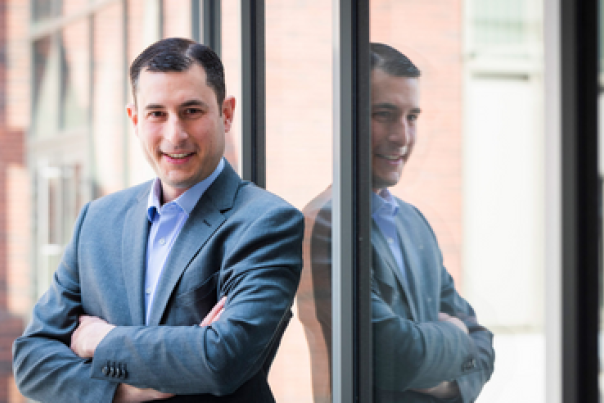
Chemical research
The Department of Chemistry has 11 laboratories that make up the 5 research units. The themes studied are health and healthcare, energy, energy storage and depollution, the pharmaceutical and chemical industry, corrosion and medical materials and innovative pedagogies.

10 years of UNamur - STÛV collaboration: a lever for innovation, attractiveness and excellence
10 years of UNamur - STÛV collaboration: a lever for innovation, attractiveness and excellence
The University of Namur and STÛV, a Namur-based company specializing in wood and pellet heating solutions, are celebrating ten years of fruitful collaboration. This partnership illustrates the importance of synergies between academia and industry to improve competitiveness and meet environmental challenges.

For over 30 years, UNamur, via its Chemistry of Inorganic Materials Laboratory (CMI) headed by Professor Bao-Lian Su, has excelled in fundamental research into catalytic solutions capable of "cleaning" air and water. In 2014, STÛV approached this expertise to design a sustainable, low-cost smoke purification system for wood-burning stoves, in anticipation of the tightening of European standards.
The R-PUR project: a decisive first step
From this meeting was born the R-PUR applied research project, funded by the Walloon Region and the European Union as part of the Beware program, led by Tarek Barakat (UNamur - CMI). Between 2014 and 2017, an innovative catalytic filter was thus developed within the laboratory, in close collaboration with STÛV.
From 2018 to 2024, the technologies patented by STÛV and UNamur and the pollutant measurement equipment were gradually transferred to STÛV, at the same time as Win4Spin-off and Proof of Concept funding enabled technological and commercial maturities to be increased to meet market needs. These steps led to laying the foundations for a new Business Unit at STÛV, with the hiring of Tarek Barakat as Project Manager, and raising investments to produce the catalytic filters.
What about tomorrow? Towards zero-emission combustion
The UNamur-STÛV collaboration continues today with the Win4Doc (doctorate in business) DeCOVskite project, led by PhD student Louis Garin (UNamur - CMI) and supervised by Tarek Barakat. Objectives:
- Develop a second generation of catalysts to completely reduce fine particle emissions.
- Limit the use of precious metals.
- Sustain biomass combustion and make STÛV the world leader in zero-emission stoves.
A winning partnership for the region
This collaboration has enabled:
- The acquisition and transfer of know-how and equipment between UNamur and STÛV to validate results under industrial conditions.
- The organization of multidisciplinary workshops, such as the one on October 14, promoting the sharing of expertise around biomass combustion and sustainable development.
Success-Story: interviews and testimonials
At the end of October, members of UNamur and STÛV came together to take part in a workshop organized by UNamur's Research Administration and STÛV. The aim? To highlight the benefits of collaborative research between companies and universities on subjects ranging from energy, the environment, profitability, ethics and regulation to sustainable development. The two partners discussed their collaboration, expertise and development prospects.
Discover the details of this success story in this video :


DCF, a molecular weapon against bacterial defenses
DCF, a molecular weapon against bacterial defenses
At a time when bacterial resistance to antibiotics is a public health problem, Professor Stéphane Vincent's team is currently developing dynamic constitutional frameworks (Dynamic Constitutional Frameworks, DCF): a molecular system that would be able to break down certain resistances and thus deliver antibiotics as close as possible to pathogens.

Scientific discoveries are like great stories: they often begin with an encounter. Nearly 20 years ago, Professor Stéphane Vincent of UNamur's Laboratoire de Chimie Bio-Organique, then a young sugar chemist, was in search of something new. During a post-doctorate in Strasbourg, France, in the laboratory of Jean-Marie Lehn, winner of the 1987 Nobel Prize in Chemistry and a specialist in supramolecular chemistry, he befriended another post-doctoral fellow: the Romanian Mihail Barboiu, now a CNRS researcher in Montpellier.
."Research carried out between Montpellier and Strasbourg has given rise to what we call Dynamic Constitutional Frameworks", reveals Stéphane Vincent. "These are molecules that are constantly assembling and disassembling, which gives them interesting properties. Weakly toxic to animal and human cells, DCFs can interact with essential cell components, such as proteins or DNA."

Soon before the Covid-19 pandemic, at a scientific congress, Mihail Barboiu showed Stéphane Vincent the results of his experiments. "He was using DCFs as a kind of transporter, to bring genes (DNA or RNA fragments) into a cell", recalls the chemist. "I then realized that DCFs were positively-charged molecules and readily adapted to DNA, which is negatively-charged. This gave me the idea of using them against bacteria, in the same way as certain antibiotics, which are also positively charged."
An antibacterial turnaround
The two researchers then established an initial research project, with a thesis funded in cotutelle by UNamur, which culminated in 2021 in the publication of the first results showing the antibacterial activity of DCFs. "At the time, I was already working on antibacterial approaches, particularly against Pseudomonas aeruginosa, a major pathogen that forms biofilms", explains Stéphane Vincent.
To combat antiseptics and antibiotics, bacteria proceed in several ways. In addition to developing mechanisms to block the functioning of antibiotics, they are able to aggregate or dock themselves to a surface, for example that of a medical implant, and cover themselves with a complex tangle of all sorts of molecules. The latter, known as biofilm, protects the bacteria from external aggression. These biofilms are a major public health problem, as they enable bacteria to survive even the most powerful antibiotics and are notably the cause of nosocomial diseases, infections contracted during a stay in a healthcare establishment.
"We have shown that certain DCFs are both capable of inhibiting biofilm production, but also of weakening them, thereby exposing bacteria to their environment", summarizes Stéphane Vincent.
The TADAM project, a European alliance!
Bolstered by these results and thanks to C2W, a "very competitive"European program that funds post-doctorates, Stéphane Vincent invited Dmytro Strilets, a Ukrainian chemist who had just completed his thesis under the supervision of Mihail Barboiu, to work in his laboratory on DCFs. The project, called TADAM and carried out in collaboration with researchers Tom Coenye of UGent and Charles Van der Henst of the VUB, then focused on the antibacterial and antibiofilm potential of DCFs against Acinetobacter baumannii, a bacterium which, along with Pseudomonas aeruginosa, is on the list of pathogens of greatest concern defined by the World Health Organization (WHO).
The TADAM project is based on an ingenious assembly: DCFs are associated with special molecules known as pillarenes. The latter form a sort of cage around a proven antibiotic molecule, levofloxacin, thus improving its bioavailability and stability. The DCFs then have the role of inhibiting and disintegrating the biofilm, to enable the pillarenes to deliver their antibiotic directly to the bacteria thus exposed.
The results obtained by Stéphane Vincent's team are spectacular: the DCF-pillararene-antibiotic assembly is up to four times more effective than the antibiotic used alone! Noting that little work had yet been done on the antibiotic effect of these new molecules, the researchers decided to protect their invention by filing a joint patent, before going any further.
For everything still remains to be done. Firstly, because despite more than convincing results, how the assembly works is still obscure. "All the study of the mechanism of action has yet to be done, says Stéphane Vincent. "How is the antibiotic arranged in the pillararene cage? Why do DCFs have antibiofilm activity? How do DCFs and pillararenes fit together? All these questions are important, not only to understand our results, but also to eventually develop new generations of molecules."
And on this point, Stéphane Vincent wants to be particularly cautious. "We all dream, of course, of a universal molecule that will work on all pathogens, but we have to be humble, he pauses. "I've been working with biologists for many years, and I know that biological reality is infinitely more complex than our laboratory conditions. But it's because our results are so encouraging that we must persevere down this path."
The chemist already has several leads: "We're going to test the molecules on bacteria"circulating"suspended in a liquid, which behave very differently. And then we're also going to work on clinical isolates of pathogenic bacteria, to get a little closer to the real conditions under which these biofilms form."
Dmytro Strilets has just received a Chargé de Recherche mandate from the FNRS to develop second-generation DCFs and study their mode of action. The TADAM project has received funding from the University of Namur and the European Union's Horizon 2020 research and innovation program under Marie Skłodowska-Curie grant agreement n°101034383.
This article is taken from the "Eureka" section of Omalius magazine #38 (September 2025).


Laura Gagliardi visits the UNamur in the framework of the prestigious Solvay/Syensqo Chair in Chemistry
Laura Gagliardi visits the UNamur in the framework of the prestigious Solvay/Syensqo Chair in Chemistry
Laura Gagliardi is a renowned international researcher at the University of Chicago, recognized for her pioneering contributions to theoretical and computational chemistry, particularly in the study of reticular materials such as metal–organic frameworks (MOFs). The Solvay/Syensqo Chair in Chemistry honors chemists who have made exceptional advances in their fields. As part of this distinction, Professor Gagliardi delivered a series of lectures at several Belgian universities, including a seminar at the University of Namur, Department of Chemistry.

Your research ranges from fundamental to applied chemistry. Can you explain what you do?
My background is in fundamental chemistry and physics—the study of the basic principles that govern matter, from atoms and molecules to the chemical bonds that connect them. During my Ph.D., I focused on developing theoretical concepts and converting them into computer codes, which required a lot of mathematics, rigor, and careful methodology.
I have always been fascinated by physical and theoretical chemistry. Synthetic chemistry in the lab can sometimes be compared to cooking—you follow a recipe and observe the results. My husband is an organic chemist and also the cook in our family; he always tells me to go play the piano while he’s in the kitchen! I’m not allowed anywhere near it. 😊
What truly fascinates me is understanding why things work in a certain way, not just that they work. My group performs computer simulations that allow us to probe reaction mechanisms at the molecular level. These simulations help us explain experimental observations, make quantitative predictions, and even design new molecular systems and materials that can later be tested and refined in the laboratory.
Currently, a large portion of my research focuses on metal–organic frameworks, or MOFs—materials made of metal ions/clusters linked by organic molecules. MOFs are exciting because of their enormous surface areas and highly tunable pore structures, which make them ideal for a wide range of applications. We are particularly interested in using MOFs to address climate change challenges, for example, by capturing carbon dioxide, storing hydrogen, and purifying water. Beyond these, MOFs are also being explored for catalysis, drug delivery, and even as sensors for detecting pollutants and biomolecules.
The Nobel Prize in Chemistry has just been awarded to three renowned scientists: S. Kitagawa, O. M. Yaghi and the late R. Robson for their work on metal-organic structures (MOFs). They have created molecular constructs with large spaces through which gases and other chemicals can flow: to collect water from desert air, capture carbon dioxide, store toxic gases or catalyze chemical reactions.

You're a scientific leader in the field of computational chemistry. How did you come to choose this path?
I grew up in Italy, in a very supportive environment. My mother was a mathematics teacher, and my father was an engineer, so I was surrounded by numbers, logic, and curiosity from an early age. I was always drawn to mathematics, physics, and chemistry, and my parents encouraged me to be ambitious and to pursue excellence in whatever I did. Their support and belief in me gave me the confidence to follow my curiosity wherever it led.
During your education, did you encounter difficulties linked to the fact that you are a woman?
Of course. At that time, society was still very stereotyped and biased. My grandfather, who admired my determination, used to say I would become a high school headmaster—that was already considered quite an achievement for a woman then! My professors were kind and encouraging, but when they saw my academic performance, they assumed I would become a high school teacher, which was considered the highest position most people could imagine for a woman in science. Nobody would have said “astronaut” or “CEO of a large company”—those roles were thought to be reserved for men. Things turned out differently. By the time I was doing my Ph.D., my parents were proud of me, though I don’t think they expected me to have this kind of career. And I am truly passionate about my job—it never feels routine.
Do you have a message for the young generation?
The most important thing is to find your passion. You will spend a large part of your life working, so you might as well do something you genuinely love. When you love what you do, you naturally find the strength and motivation to persevere.
I like to quote the Italian author Primo Levi, who wrote in the Wrench: “Finding a job you like is the closest approximation to happiness in this world.” As a woman—and even though things have improved—you still have to work very hard to demonstrate your worth. I deeply believe in excellence, and I value it when I see it in others, regardless of gender. Excellence speaks for itself.
I also believe that family, friends, and mentors are indispensable sources of inspiration. You need role models and supportive figures to help you grow, stay passionate, and strive for excellence. We are fortunate to live in a privileged environment where many opportunities are within reach.
My advice is to use that privilege to make a difference—by finding your passion and pursuing it wholeheartedly.

Laura Gagliardi - Biography
Laura Gagliardi is a professor at the University of Chicago, United States of America.
Picture credit - University of Chicago
After her scholarship in Bologna, Italy, a post-doctoral position in Cambridge, England, she began her independent academic career in Palermo, Italy, then in Geneva, Switzerland. In 2009, she moved to the United States where she was a professor at the University of Minnesota. She remained there until her move to the University of Chicago in 2020. She is the Richard and Kathy Leventhal Professor at the University of Chicago with a joint appointment at the Department of Chemistry and the Pritzker School of Molecular Engineering.
In addition to her dedication to science, Laura is a strong advocate for women in science, technology, engineering, and mathematics.
The Syensqo 2025 Chair in Chemistry at the Solvay International Institutes
Laura Gagliardi was awarded this prestigious Solvay chair in Chemistry for her groundbreaking work on electronic structure methods for complex chemical systems, which highlights her leadership and impact on the world of chemistry.

Laura Gagliardi's visit to the University of Namur on October 22, 2025, was an excellent opportunity for undergraduate, master, and doctoral students, as well as postdoctoral researchers from the chemistry and physics departments working in the field of computational chemistry and numerical simulations of functional materials, to meet and exchange ideas with a world-renowned figure.
Chemistry and physics research at UNamur
At the University of Namur, their research is conducted at the Namur Institute for Structured Matter (NISM) and is dedicated to the development and application of new computational methodologies to characterize and understand the properties of functional materials for applications in the fields of nonlinear optics, energy storage, catalysis, organic electronics, photochemistry, and photophysics.
Contacts: benoit.champagne@unamur.be - vincent.liegeois@unamur.be - yoann.olivier@unamur.be

First MG-ERC conference brings together the world's inorganic chemistry elite
First MG-ERC conference brings together the world's inorganic chemistry elite
In early September, the University of Namur hosted the first Main-Group Elements Reactivity Conference (MG-ERC). Over 100 researchers from 12 countries and 32 institutions gathered around Professor Guillaume Berionni. An event hailed as "one of the best chemistry conferences" by its prestigious guests.

A unique event
The first MG-ERC conference, dedicated to advances in inorganic chemistry, coordination chemistry and catalysis, is a first in Europe. Over a hundred researchers from 12 countries and 32 institutions accepted the invitation from Professor Guillaume Berionni, who organized the event with Professor Steven Nolan (Ghent University). The two researchers succeeded in bringing together leading experts working in the fields of heteroatom chemistry, coordination chemistry, catalysis, and inorganic chemistry.
An acclaimed first
The luminaries from prestigious universities (Oxford, Berlin, Laval, Paris-Saclay...) unanimously praised the scientific excellence and "exemplary" organization of this first edition. Many even described MG-ERC as "one of the best chemistry conferences" they had ever attended.
.An initiative supported by UNamur
The driving force behind this European first is Professor Guillaume Berionni, director of the laboratory in reactivity and organometallic catalysis (RCO) at UNamur and a member of the Namur Institute of Structured Matter (NISM). His team of 14 researchers is dedicated to the reactivity of main group elements and the development of new approaches to catalysis.

Strong support
The event was co-financed by the European Research Council (ERC), ChemistryEurope, the Royal Society of Chemistry, the CGB, the FNRS CHIM Doctoral School, the NISM, as well as several industrial partners (ACS Publications, Analis & Advion Interchim Scientific®, BUCHI, Chemical Synthesis, Magritek). The organizers would like to thank these sponsors for their support in raising the international profile of this first event. They have also made it possible to award prizes for the best oral and poster presentations by young researchers.
Guillaume Berionni in brief
- Doctorate in Science (2010, Université de Versailles, Institut Lavoisier).
- Post-doctorate at Ludwig Maximilian University Munich (Humboldt fellow).
- Professor of Chemistry at the University of Namur since 2017.
- Winner of a Mandat d'Impulsion Scientifique (MIS) from the FNRS in 2018.
- ERC Consolidator Grant (2023) for the B-YOND
- Elected Member of Chemistry Europe (2024-2026).
- Triennial Prize of the Royal Society of Chemistry (2025).

Chemical research
The Department of Chemistry has 11 laboratories that make up the 5 research units. The themes studied are health and healthcare, energy, energy storage and depollution, the pharmaceutical and chemical industry, corrosion and medical materials and innovative pedagogies.
Agenda
Public defense of doctoral thesis in chemical sciences - Liuxi Yang
Topological engineering of triptycene-based ionic frameworks (TIFs)
Jury
- Dr. Nikolai TUMANOV (UNamur), President
- Prof. Bao-Lian SU (UNamur), Secretary
- Prof. Yann GARCIA (UCLouvain)
- Prof. Teng BÊN (Jinhua University)
- Prof. Guillaume BERIONNI (UNamur)
- Prof. Alain KRIEF (UNamur)
- Prof. Alain KRIEF (UNamur)
Abstract
Porous crystals with structural flexibility are difficult to realize because flexible molecules often rearrange or leave the lattice, leading to pore collapse. Since the early 2000s, it has become clear that combining robust intermolecular interactions with flexible linkers and deformable nodes can stabilize porous crystals during guest removal. Frameworks such as MOFs, COFs, and HOFs benefit from strong noncovalent interactions, yet permanently porous HOFs remain uncommon due to dense molecular packing.
Porous organic salts (POSs) offer an alternative strategy, assembling predictable networks from oppositely charged organic ions where electroneutrality and stoichiometry guide structure formation. However, most 3D POSs rely on planar guanidinium or tetrahedral tetraphenylmethane derivatives, resulting in a narrow set of topologies compared with the thousands of 3D nets catalogued in the Reticular Chemistry Structure Resource (RCSR).
Here we report triptycene-based ionic frameworks (TIFs) formed via charge-assisted ammonium-sulfonate hydrogen bonding. By tuning triptycene symmetry and functionalization, together with sulfonate linker geometry, we generated diverse supramolecular architectures with tailored porosity, stability, and function.
